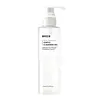What's inside
What's inside
 Key Ingredients
Key Ingredients

 Benefits
Benefits

 Concerns
Concerns

 Ingredients Side-by-side
Ingredients Side-by-side

Water
Skin ConditioningGlycerin
HumectantSodium Cocoyl Alaninate
Lauryl Hydroxysultaine
CleansingLauryl Glucoside
CleansingQuillaja Saponaria Bark Extract
CleansingSodium Hyaluronate
HumectantHydrolyzed Hyaluronic Acid
HumectantHyaluronic Acid
HumectantAcrylates/C10-30 Alkyl Acrylate Crosspolymer
Emulsion StabilisingCoco-Betaine
Cleansing1,2-Hexanediol
Skin ConditioningCaprylyl Glycol
EmollientCoco-Glucoside
CleansingSodium Cocoyl Isethionate
CleansingSodium Myristoyl Glutamate
CleansingProtease
ExfoliatingButylene Glycol
HumectantPropanediol
SolventBenzyl Glycol
SolventHydrolyzed Glycosaminoglycans
HumectantSodium Hyaluronate Crosspolymer
HumectantEthylhexylglycerin
Skin ConditioningHydroxypropyltrimonium Hyaluronate
Sodium Acetylated Hyaluronate
HumectantCitric Acid
BufferingSodium Chloride
MaskingWater, Glycerin, Sodium Cocoyl Alaninate, Lauryl Hydroxysultaine, Lauryl Glucoside, Quillaja Saponaria Bark Extract, Sodium Hyaluronate, Hydrolyzed Hyaluronic Acid, Hyaluronic Acid, Acrylates/C10-30 Alkyl Acrylate Crosspolymer, Coco-Betaine, 1,2-Hexanediol, Caprylyl Glycol, Coco-Glucoside, Sodium Cocoyl Isethionate, Sodium Myristoyl Glutamate, Protease, Butylene Glycol, Propanediol, Benzyl Glycol, Hydrolyzed Glycosaminoglycans, Sodium Hyaluronate Crosspolymer, Ethylhexylglycerin, Hydroxypropyltrimonium Hyaluronate, Sodium Acetylated Hyaluronate, Citric Acid, Sodium Chloride
Water
Skin ConditioningCetyl Ethylhexanoate
EmollientDipropylene Glycol
HumectantGlycerin
HumectantPolyglyceryl-10 Diisostearate
EmulsifyingHydroxypropyl Starch Phosphate
PEG-75
HumectantPentylene Glycol
Skin ConditioningPolyglyceryl-2 Triisostearate
EmulsifyingYogurt
Skin ProtectingAdansonia Digitata Seed Oil
EmollientLimnanthes Alba Seed Oil
Skin ConditioningDipotassium Glycyrrhizate
HumectantSilica
AbrasiveStearic Acid
CleansingArachidyl Alcohol
EmollientCarbomer
Emulsion StabilisingSodium Stearoyl Glutamate
CleansingButylene Glycol
HumectantTocopherol
AntioxidantAscorbyl Palmitate
AntioxidantPotassium Hydroxide
BufferingWater, Cetyl Ethylhexanoate, Dipropylene Glycol, Glycerin, Polyglyceryl-10 Diisostearate, Hydroxypropyl Starch Phosphate, PEG-75, Pentylene Glycol, Polyglyceryl-2 Triisostearate, Yogurt, Adansonia Digitata Seed Oil, Limnanthes Alba Seed Oil, Dipotassium Glycyrrhizate, Silica, Stearic Acid, Arachidyl Alcohol, Carbomer, Sodium Stearoyl Glutamate, Butylene Glycol, Tocopherol, Ascorbyl Palmitate, Potassium Hydroxide
 Reviews
Reviews

Ingredients Explained
These ingredients are found in both products.
Ingredients higher up in an ingredient list are typically present in a larger amount.
Butylene Glycol (or BG) is used within cosmetic products for a few different reasons:
Overall, Butylene Glycol is a safe and well-rounded ingredient that works well with other ingredients.
Though this ingredient works well with most skin types, some people with sensitive skin may experience a reaction such as allergic rashes, closed comedones, or itchiness.
Learn more about Butylene GlycolGlycerin is already naturally found in your skin. It helps moisturize and protect your skin.
A study from 2016 found glycerin to be more effective as a humectant than AHAs and hyaluronic acid.
As a humectant, it helps the skin stay hydrated by pulling moisture to your skin. The low molecular weight of glycerin allows it to pull moisture into the deeper layers of your skin.
Hydrated skin improves your skin barrier; Your skin barrier helps protect against irritants and bacteria.
Glycerin has also been found to have antimicrobial and antiviral properties. Due to these properties, glycerin is often used in wound and burn treatments.
In cosmetics, glycerin is usually derived from plants such as soybean or palm. However, it can also be sourced from animals, such as tallow or animal fat.
This ingredient is organic, colorless, odorless, and non-toxic.
Glycerin is the name for this ingredient in American English. British English uses Glycerol/Glycerine.
Learn more about GlycerinWater. It's the most common cosmetic ingredient of all. You'll usually see it at the top of ingredient lists, meaning that it makes up the largest part of the product.
So why is it so popular? Water most often acts as a solvent - this means that it helps dissolve other ingredients into the formulation.
You'll also recognize water as that liquid we all need to stay alive. If you see this, drink a glass of water. Stay hydrated!
Learn more about Water